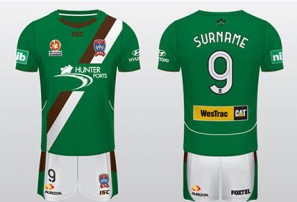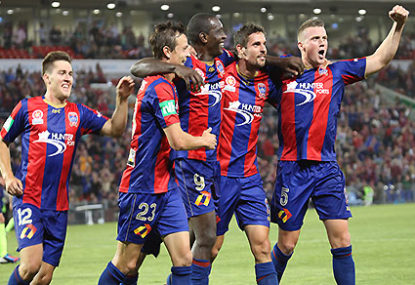Last Friday, Newcastle Jets announced the winning design for its 2013-2014 away kit. There were three kits to choose from but, by popular demand, the winning design was hardly new.
In fact, the emerald green and cinnamon jersey is a deliberate reference to the colours worn by Newcastle KB United, an iconic club that played in the region during the National Soccer League.
In March, I wrote about the MLS initiative to include fans and history into the design of their kits. I suggested the A-League follow suit.
Bravo to Newcastle for this fan-generated initiative. Some will argue it doesn’t mean much, but that’s being needlessly cynical.
Symbolism is crucial to our sporting culture. Practically, it may mean very little to the everyday business of running a football club, but for fans it can mean everything.
Remember the backlash when Perth Glory flirted with the idea of changing their name and their colours in the early days of the A-League? The truth is that club colours, names and logos are key markers of identification, and an important statement of intent.
Its a truism which crosses football codes. Parramatta Eels are just one example. The Eels nickname is derived from the Anglicised local Aboriginal word ‘Parramatta’, meaning “place where the eels dwell.”
The Eels logo has been subject to some renovation over time, but in recent years the logo was switched back to the original circular eel, discarding those horrible modern logos of the early 2000s.
Most fans seem far happier to be back with the original. Rugby league, after the ravages of the Super League wars, has been left dangling between its working class traditions and its desire for commercial success.
The AFL, on the other hand, has an enviable track record of not messing with its heritage.
But in football, preservation of our past has not been a strong point.
Michael Cockerill wrote an interesting piece recently, imploring clubs to maintain their names and preserve their histories. He’s right, but by putting the onus on the clubs, Cockerill overlooks one key point.
Most Australian football clubs have actually been forced to change their names by various governing bodies, both at a state and national level.
In the history of the national league, we’ve had Dolphins, Sharks, Lakers and Breakers, not to mention Knights, Raiders, Strikers, Gladiators, Warriors, Kingz and Gunners.
We’ve seen Rams, Stallions, Leopards and Lions play Hawks, Falcons, Crows and Eagles. Cosmos, Spirit, Power, Pride, Giants, Force – the list goes on.
But who remembers the clubs that belonged to these nicknames? Very few I suspect.
Sydney United ’58 are one such example. The club has been through so many enforced name changes it’s ridiculous.
Metropolitan Adriatic, Croatia, South Sydney Croatia, Sydney Croatia, Sydney CSC, Sydney Crows, Sydney Pumas, Sydney United, and most recently, Sydney United ’58.
The list might be exhaustive, but the point is that without the meddling of the former governing body the club probably would have never changed from Sydney Croatia. And nor should they have had to.
Still, we’re in a different era these days, and incorporating history into the A-League can be tricky. There’s not a lot of A-League history to speak of just yet, and cherry-picking bits and pieces from the NSL isn’t as straightforward as it sounds.
However, initiatives like the one in Newcastle are worth encouraging. Newcastle KB United are one of the iconic clubs in the region, and deserve recognition in the modern Novocastrian football culture.
When they entered the NSL in 1978, they drew record crowds and marquee players like Bobby Charlton and Craig Johnson.
On the issue of club symbols, it is also worth remembering that once upon a time, even Newcastle KB United’s name was cause of some contestation.
When Marconi received sponsorship from car company Datsun in 1981, the club briefly rebranded itself Marconi-Datsun Leopards.
It remains my all time favourite name in Australian football history, if only for its sheer silliness.
But the Australian Soccer Federation didn’t much like it, and Marconi were pressured to remove ‘Datsun’ from their moniker. The club objected, pointing to the ‘KB’ in Newcastle’s name.
The hypocrisy was plain to see, but eventually the Datsun label faded away, as did the Leopards, in the process violating an old saying about leopards not changing their spots.
Later, the Newcastle Breakers – who entered the NSL in 1991 – continued the Newcastle tradition of having a naming rights sponsor, briefly calling themselves Newcastle BHP Breakers and Newcastle Topper Breakers in honour of their sponsors.
Names, logos and symbolism have always been a political minefield in football. Not enough independence and trust has been granted to clubs to head in their own directions.
Sadly, even less attention has been paid to fans. The A-League has inherited this problem. Who can forget the tyranny of those terrible Reebok kits?
But slowly things are changing, and fans are responding with their dollars and their respect. This might simply be a clever marketing exercise by the Hunter Sports Group, but the fact that Newcastle fans themselves voted for the historic jersey in a landslide says a lot.
It may be hopeful in the extreme, but we should work to a situation where club symbolism is a product of a democratic collaboration between the club and its fans, with regard to the cultural, geographical and historical characteristics of the region they represent, not the whims of a bureaucrat or a marketing executive.

Newcastle Jets 2013/4 away jersey (Image: Newcastle Jets)






























































































